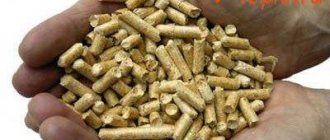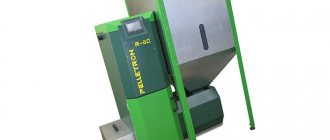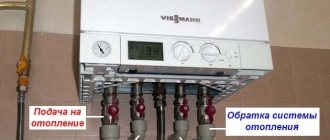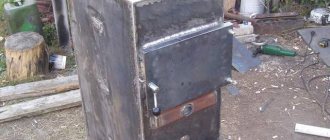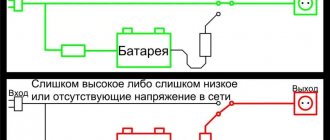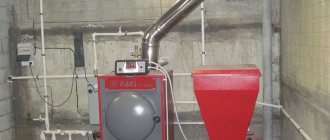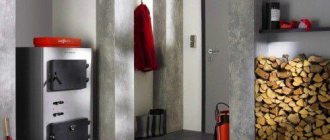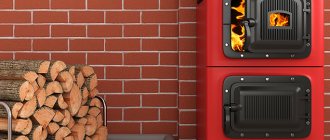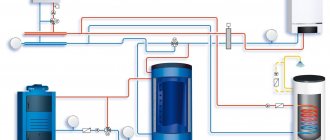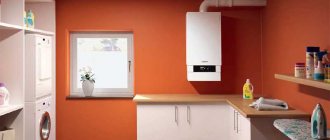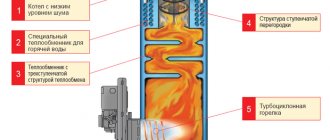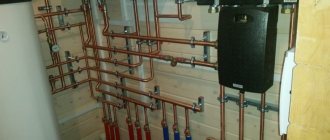The article was prepared with the participation of DOZATECH specialists
Despite the fact that our country is one of the largest exporters of blue fuel, there is no need to talk about widespread gasification. For many consumers both in Moscow and Siberia, the cheapest heating method is unattainable now, and it is not a fact that it will be available in the future. Therefore, we have to look for alternative heating sources; fortunately, the choice in this area is impressive. And in recent years, the range of heating equipment has been replenished with an interesting unit - a pellet boiler. Let us dwell in more detail on this type of equipment, for which we will consider the following aspects:
- What is a pellet heating boiler and what fuel does it use?
- Unit design.
- Advantages and disadvantages of a pellet boiler.
- What to look for when choosing a unit.
What is a pellet boiler
In essence, this is a type of solid fuel boiler, but designed for a specific type of fuel (pellets) and with the possibility of full or partial automation of the work process.
It is the ability to function autonomously with minimal intervention from the owners that makes pellet boilers radically different from conventional solid fuel boilers.
They have a higher efficiency (efficiency factor) - both due to the characteristics of the pellets and due to the design features. Pellet boilers can be either highly specialized - intended only for pellets, or combined (universal) - capable of running on wood or coal, some models operate on almost any biomass; husks, wood waste and the like can be used as fuel.
Alexander DimitrevRepresentative of DOZATECH, a manufacturer of pellet boilers
With a certain boiler design, it can burn any biomass of very low calorie content - wood chips, bark, wood waste, agricultural waste, sunflower husks and more.
Pellets, or wood pellets, are environmentally neutral fuel, obtained mainly from waste from the wood processing industry (chips, shavings, bark), but they can also be from agricultural waste. Pellets appeared in the thirties of the last century, when the first installation for pressing waste from local sawmills into pellets was invented and tested in the state of Idaho. Under strong pressure, the raw material mass is heated, which provokes the formation of lignin, which binds the smallest particles into dense, smooth granules. This allows you to abandon the use of chemicals - pellets are a completely natural, environmentally safe fuel. The diameter of the granules varies between 6-8 mm, length – up to 50 mm. In European countries, pellets are classified as standardized fuels and are produced according to the DIN plus standard.
In our country, their production is not so developed and supervised; the quality of the granules, on which both the efficiency of the boiler and its performance will depend, is determined visually - white ones are better than gray ones. Unlike wood, pellets have low humidity and high density, which is why when burning, more heat is released and a minimal amount of carbon dioxide is released. If we translate this property into numbers, for comparison, we get the following ratio: when burning a ton of pellets, the same amount of heat will be released as when burning 1.6 tons of firewood. The ash content will be only 0.5% of the burned volume, and the emitted flue gases will be colorless.
The approximate calorific value of pellets is 5 kW/hour per kilogram, but how close the actual efficiency will be to the theoretical data depends on the quality of the pellets themselves and on the performance of the boiler in which they will be burned.
Features of the boiler room depending on the type of fuel
Let's consider what features there are for different types of solid fuel used, what a boiler room should be like for a solid fuel boiler using different types of burned materials.
Wood boiler room
Actually, a wood-burning boiler room is a classic room for a solid fuel boiler, which can have minimal dimensions. The main differences between different rooms are the size from the firebox door to the wall or boiler room doors. It depends on the length of the log used.
If long logs are used, then the distance is at least 2 meters. After all, you will not only have to load logs into the firebox, but also open / swing open the firebox door.
If you heat with briquettes or eurowood, then this distance may be minimal. Just don’t forget that in addition to loading firewood, you will also have to remove the ash, which will also require free space in front of the firebox / ash pan.
Pellet boiler room
The size of the pellet boiler room will depend on how the pellet hopper is installed. A pellet boiler room will not only differ in floor area, but also in the height of the boiler room.
Unit design
The pellet boiler itself consists of three main components:
- Furnace - equipped with a special burner (retort or torch) and two doors (control, cleaning).
- Convective zone - a heat exchanger is located in it: it can be vertical, horizontal or combined, tubular or plate type. In the convective zone, the coolant in the heat exchanger is heated by gases released during the combustion of pellets. Most units are designed only for heating and have one circuit, but some models have two circuits: heating and water heating.
- Ash pan - it receives combustion waste (insignificant during normal afterburning), which is periodically removed through the cleaning door.
However, the listed components are, although the main part, but only a part, the operation of which requires the APT attachment (automatic fuel supply). This attachment includes the following components:
- A hopper is a container for pellets of a certain volume, from which the pellets enter the combustion chamber; it can be built-in or external.
- Auger - portions feed granules to the burner as needed, driven by a gearbox.
- A fan is necessary to maintain the combustion process, since the boiler design does not provide for natural draft.
Since the pellet boiler is an automated system, its device also includes a control unit with a display, which displays information about the current state, and through which the main operating parameters are set. The controller regulates the ignition of the burner, the supply of pellets and air, and stops when the desired temperature is reached, maintaining the heating mode selected by the owner.
Depending on the capacity of the bunker and the selected mode, one filling can be enough for several days, a week or even more.
To make the heating process fully automatic, the boiler can be connected directly to the storage - a pneumatic pipe will supply granules to the bunker as it is emptied.
Installation location
The boiler room must comply with fire safety requirements. The PC must stand on a non-flammable platform located above the floor surface so that during operation or repair dangerous situations do not arise:
- fuel fire;
- getting burns while servicing a PC;
- carbon monoxide poisoning due to weak draft and non-functional ventilation.
To increase the reliability of equipment operation, a safety automatic system is installed on the boiler, equipped with temperature and pressure sensors. For efficient operation of the system as a whole, a battery tank is placed when installing the PC. Therefore, it will require additional space at the rate of 50.0 liters per 1 kW of boiler power. Optimizing the thermal design by using a tank results in 30% fuel savings and protects the PC from overheating.
Photo: picspedia.ru
The total weight of the equipment according to this scheme is large, which must be taken into account when calculating the load on the boiler room floor.
In addition, the area under the unit must be well insulated, otherwise the condensation process under the device will constantly occur.
Advantages and disadvantages of a pellet boiler
One of the main advantages of pellet boilers is their efficiency; in this indicator they are second only to gas main heating. This is due to the high efficiency of the equipment, the high calorific value of pellets, and their affordable cost. The second aspect that attracts consumers is process automation. Unlike other solid fuel boilers, pellet boilers do not require constant monitoring and regular manual fuel supply. It also wins over units running on diesel fuel in terms of environmental friendliness - no odors or black smoke.
The main disadvantage of these units is their substantial price - these are the most expensive solid fuel units, the cost of an automated station made in Europe is measured in hundreds of thousands, domestic ones are slightly cheaper. Not every private owner can afford such investments into the heating system of their home. However, with equipment longevity now approaching two decades, it is a wise investment in the long term.
In addition to the high cost, the disadvantages include energy dependence - the automation requires electricity, and if a shutdown of several hours (on average up to 10) is acceptable and will not disrupt the settings, then a longer shutdown will stop the operation of the boiler. The station must be equipped with an independent energy source, which will further increase the cost of the system.
What to look for when choosing a unit
Despite the relative “youth” of this type of solid fuel, there is a large selection of boilers of foreign and domestic production on the market. To choose the optimal unit for your conditions, you should pay attention to several important parameters.
Power - each manufacturer has a fairly wide range of models, including both household and industrial units. As with any heating equipment, power is measured in kilowatts (kW), the power of household models starts from 15 kW. Since heating a room with average heat loss requires about 1 kW per 10 m², such a boiler is capable of heating a house of 150 m². However, it is worth considering that the boiler is needed with a small margin.
Efficiency - the higher this indicator, the more economical the heating process. For pellet burners, the efficiency varies between 85-95% and depends both on the quality of the pellets and on the design features.
Alexander Dimitrev
The five-pass heat exchanger ensures high efficiency of the boiler - it allows you to obtain maximum heat removal when gases pass through the convective zone to the chimney.
The specialist advises paying attention to the material from which the boiler is made and the type of heat exchanger.
Alexander Dimitrev
Boilers made of thick metal (6 mm and 8 mm, depending on power) are more durable. The thickness of the metal affects the service life of the boiler; this is also important - how many years the unit will operate. A plate heat exchanger has advantages over a tubular one - it is more convenient to clean.
Equipment for solid fuel boiler rooms
What should be in the room, what should be the basic diagram of a boiler room in a private house using solid fuel?
Let's estimate the composition:
- The heat generator itself with accompanying bunkers, fuel tanks, etc.
- Solid fuel boiler piping, which includes a boiler safety group, a circulation pump and a three-way mixing valve.
- Indirect heating boiler for producing hot water for the home water supply system.
- The chimney for a TT boiler has an effective cross-section and height.
- Boiler water drainage system in case of heat generator maintenance.
- Boiler automation – in-house or weather-dependent.
- Fire extinguishing system in a solid fuel boiler room.
Here is the simplest schematic diagram of a boiler room in a private house, which takes into account both the boiler piping and the connection of an indirect heating boiler:
Conclusion
Pellet boilers are modern, environmentally friendly and cost-effective heating equipment. At the moment, they are less in demand than conventional solid fuel units, but in the future they may well conquer the market due to the high quality of heating and decent performance.
On our portal, in the forum section about boiler equipment, an entire thread is devoted to pellet boilers. No less useful and interesting is the article on how to prepare for the heating season. Another option for autonomous heating is heat pumps. In the video, a portal participant shares his experience of installing a pellet burner with his own hands.
Subscribe to our Telegram channel Exclusive posts every week
